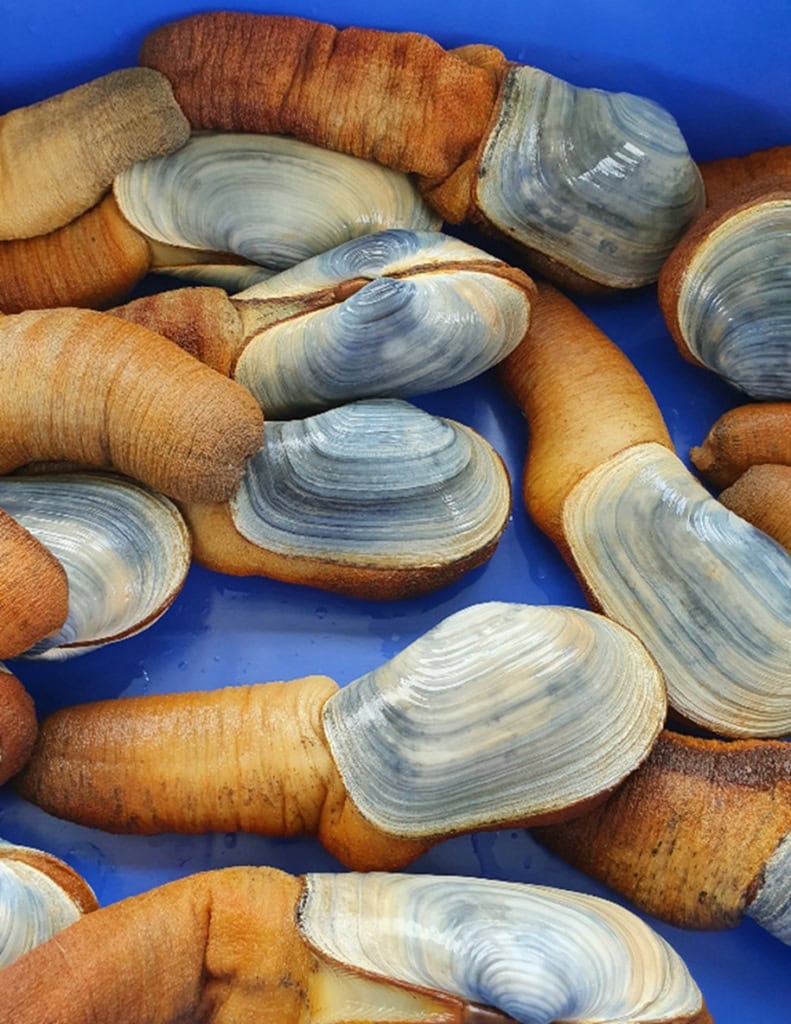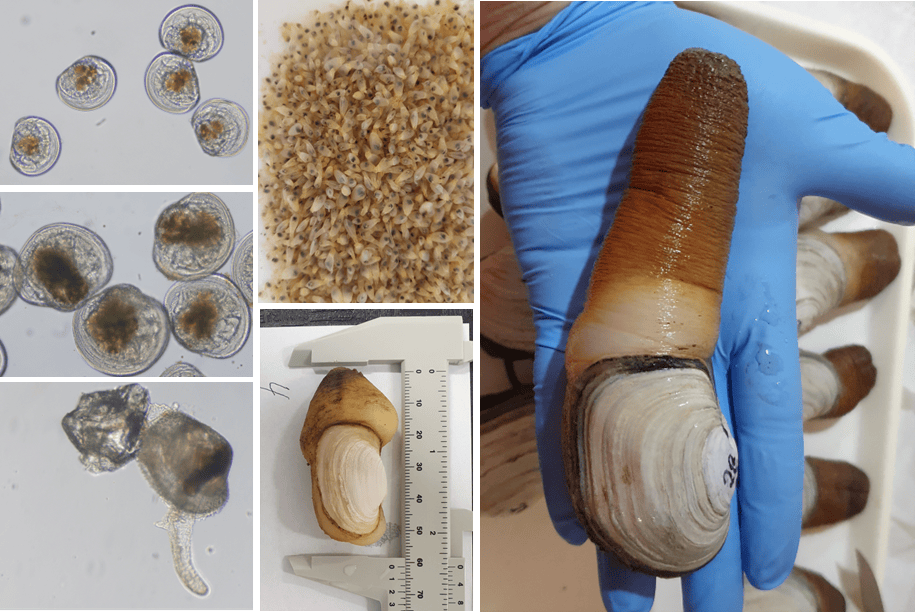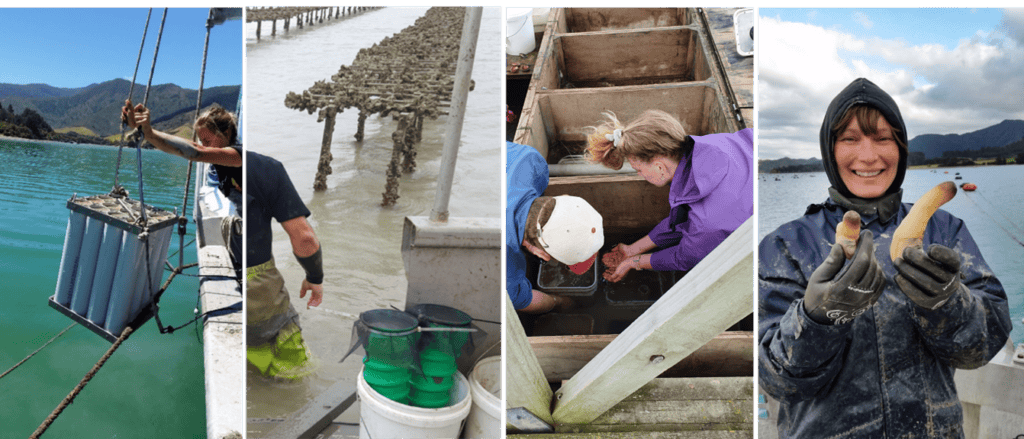The origins of the ShARP platform lie in the pioneering work over two decades to domesticate the native green-lipped mussel, which then and now forms the most important species for aquaculture in Aotearoa New Zealand (NZ). Work on domestication of new species continues to this day, and one of the species we have put a lot of effort into over the last decades is the burrowing clam known as the NZ geoduck or Panopea zelandica.

Figure 1. The New Zealand geoduck (Panopea zelandica). These individuals were large (500 – 700 g wet weight) adults removed from a subtidal sandy bed, that became part of the broodstock population used for hatchery research carried out at the Cawthron Aquaculture Park by ShARP researchers.
The NZ geoduck is one of our largest native shellfish species and lives in our shallow coastal waters in subtidal soft-sediment habitats e.g. sand or mud. However, most people have never even heard of a geoduck, let alone seen or eaten one. This is because they live buried deep down into the sand with just a tiny ‘syphon’ that looks like a small hole visible at the surface, remaining cleverly hidden from the usually oblivious swimmers and divers above. This is not the case in other parts of the world such as the Pacific Northwest of America or Asia where other geoduck species are readily found in intertidal habitats. Their intertidal geoduck cousins are more conspicuous and are often farmed and traded – usually fetching very high values due to their delicious taste and texture, which is described as somewhat similar to perfectly cooked squid but tasting sweet like a scallop. The video below shows what juvenile and adult geoduck look like in captivity at Cawthron Aquaculture Park.
The commercial potential that geoduck could have for aquaculture in NZ did not go unnoticed by ShARP researchers in the early 2000’s, and research began to investigate the feasibility of hatchery production of this poorly studied species (King 2010). Since then, this charismatic clam species became the target of ongoing research efforts to enable domestication including understanding its reproductive biology (sexual maturation, spawning, and fertilization), early life stages (embryo and larval development, and post-settlement development), as well as the implementation of this knowledge for the development of hatchery, nursery and farming technologies in collaboration with industry partners (fishers and marine farmers).

Figure 2: Geoduck (Panopea zelandica) life stages and growth in captivity. Top left: 6 day old veliger larvae measuring just 100 µm in shell length show the geoduck’s first shell. Middle left: The same veliger larvae at 18 days old and measuring 250µm shell length. Lower left: Baby geoduck 3 days post-settlement measuring just 400 µm (almost half a millimeter!) in shell length, photographed next to a grain of sand, and showing the foot emerging to find a place to burrow. Middle top: two months old juveniles measuring 15mm shell length and weighing ~0.5 g. Middle bottom: Hatchery-produced geoduck aged 10 months old, weighing ~10g and measuring 30 mm shell length. Right: Two year old hatchery-produced geoducks weighing ~100g and measuring 60 mm shell length.
What we now know from this large body of research, is that after going through their free-swimming stage as larvae, they then metamorphose and settle down – quite literally – and start to burrow in the sand at a very tiny size. Once they have done this, their survival is relatively high compared to other shellfish species, and it gets better as the animals grow. The way that growth is measured in geoduck needs to be different to most other shellfish, since most shellfish are measured by the size of their shells, but geoducks allocate a lot more energy to growing their body than their shell because once buried, they are protected by the sand and the shell stays relatively small. Land-based growth trials indicate that the NZ geoduck can take up to two years to reach 100g in weight and around 60 mm in shell length. Extrapolation of that growth curves suggests that it would take about 5 and a half years to reach 500g in a land-based farming situation
Field trials that started with juveniles transferred from the hatchery at different sizes (from as small as just 0.5 – 1g) have shown that a variety of different growing systems can accommodate this species near or in mussel and oyster farms. These systems included individual holding units on the seafloor, suspended in the water column, or even in floating upwelling systems (Figure 2). This research also sets our record for the current longest shellfish grow-out trial in NZ: at 6 years to date, this has generated a significant amount of new farming knowledge.

Figure 3. Deployment of hatchery-raised geoduck juveniles to various different grow-out systems on existing oyster and mussel farm sites, and checking the growth of the juveniles over time.
The research has also generated a large amount of biological knowledge and formed the basis of many postgraduate student research projects over the years. Together this team has identified the importance of seawater temperature and diet during sexual maturation of broodstock held in the hatchery (Le et al. 2014, Le et al. 2017a, Sharma et al. 2024), developed reliable spawning protocols, improved assisted fertilization in captivity, and characterised embryonic development and the importance of seawater temperature for normal development during embryogenesis (Let et al. 2017b, Le et al. 2018, Sharma et al. 2020). We have optimised larval rearing protocols; identifying feeding regimes and stocking densities to maximise settlement using the right settlement substrate (Le et al. 2017c). We have identified the physiological limits of juveniles to identify potential environmental challenges that could be a problem during the first months of growth after settlement, as well as the juveniles’ ability to withstand and recover from handling (Le et al. 2017d, Sharma et al. 2022, Sharma et al. 2024). Lastly, we have investigated the environmental tolerances of adults as well to help identify their potential to respond to the challenges of climate change (Le et al. 2016, Le et al. 2017e).
Overall, the successful hatchery production and body of research carried out on NZ geoduck is an excellent example of how the ShARP team can tackle and solve challenges associated with the domestication of new shellfish species. Enabling diversification can both reduce risk and add substantial value to the aquaculture sector, while building an important knowledge base around the environmental needs of some of our most overlooked but charismatic native species.

Contact Dr Leo Zamora
Research Scientist – Aquaculture diversification and new species development